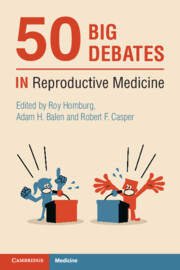Book contents
- 50 Big Debates in Reproductive Medicine
- Series page
- 50 Big Debates in Reproductive Medicine
- Copyright page
- Contents
- Contributors
- Foreword
- Introduction
- Section I Limits for IVF
- Section II IVF Add-ons
- Section III The Best Policy
- 14A IVF Should Be First-Line Treatment for Unexplained Infertility of Two Years Duration
- 14B IVF Should Be First-Line Treatment for Unexplained Infertility of Two Years Duration
- 15A Single Embryo Transfer Should Be Performed in All IVF Cycles
- 15B Single-Embryo Transfer Should Be Performed in All IVF Cycles
- 16A The Freezing of All Embryos Should Be Used for All IVF Cycles
- 16B The Freezing of All Embryos Should Be Used for All IVF Cycles
- 17A Luteal-Phase Support Should Be Stopped at the Time of a Positive Pregnancy Test
- 17B Luteal Phase Support Should Be Stopped at the Time of a Positive Pregnancy Test
- 18A A Natural Cycle Is the Best Protocol for Frozen Embryo Replacement
- 18B A Natural Cycle Is the Best Protocol for Frozen Embryo Replacement
- 19A All Pregnancies Conceived by IVF Should Be Delivered by Caesarean Section
- 19B All Pregnancies Conceived by IVF Should Be Delivered by Caesarean Section
- 20A Endometriosis Should Be Suppressed for 6–12 Weeks before Frozen Embryo Transfer
- 20B Endometriosis Should Be Suppressed for 6–12 Weeks before Frozen Embryo Transfer
- 21A Infertile Patients with Endometriosis Benefit from Surgery
- 21B Infertile Patients with Endometriosis Benefit from Surgery
- 22A Intramural Fibroids Greater than 4 cm in Diameter Should Be Removed to Aid Fertility
- 22B Intramural Fibroids Greater than 4 cm in Diameter Should Be Removed to Aid Fertility
- 23A All Infertile Women with a Uterine Septum Should Have a Surgical Removal
- 23B All Infertile Women with a Uterine Septum Should Have a Surgical Removal
- Section IV Embryology
- Section V Ethics and Statistics
- Section VI Male-factor Infertility
- Section VII Genetics
- Section VIII Ovarian Stimulation
- Section IX Hormones and the Environment
- Index
- References
16A - The Freezing of All Embryos Should Be Used for All IVF Cycles
For
from Section III - The Best Policy
Published online by Cambridge University Press: 25 November 2021
- 50 Big Debates in Reproductive Medicine
- Series page
- 50 Big Debates in Reproductive Medicine
- Copyright page
- Contents
- Contributors
- Foreword
- Introduction
- Section I Limits for IVF
- Section II IVF Add-ons
- Section III The Best Policy
- 14A IVF Should Be First-Line Treatment for Unexplained Infertility of Two Years Duration
- 14B IVF Should Be First-Line Treatment for Unexplained Infertility of Two Years Duration
- 15A Single Embryo Transfer Should Be Performed in All IVF Cycles
- 15B Single-Embryo Transfer Should Be Performed in All IVF Cycles
- 16A The Freezing of All Embryos Should Be Used for All IVF Cycles
- 16B The Freezing of All Embryos Should Be Used for All IVF Cycles
- 17A Luteal-Phase Support Should Be Stopped at the Time of a Positive Pregnancy Test
- 17B Luteal Phase Support Should Be Stopped at the Time of a Positive Pregnancy Test
- 18A A Natural Cycle Is the Best Protocol for Frozen Embryo Replacement
- 18B A Natural Cycle Is the Best Protocol for Frozen Embryo Replacement
- 19A All Pregnancies Conceived by IVF Should Be Delivered by Caesarean Section
- 19B All Pregnancies Conceived by IVF Should Be Delivered by Caesarean Section
- 20A Endometriosis Should Be Suppressed for 6–12 Weeks before Frozen Embryo Transfer
- 20B Endometriosis Should Be Suppressed for 6–12 Weeks before Frozen Embryo Transfer
- 21A Infertile Patients with Endometriosis Benefit from Surgery
- 21B Infertile Patients with Endometriosis Benefit from Surgery
- 22A Intramural Fibroids Greater than 4 cm in Diameter Should Be Removed to Aid Fertility
- 22B Intramural Fibroids Greater than 4 cm in Diameter Should Be Removed to Aid Fertility
- 23A All Infertile Women with a Uterine Septum Should Have a Surgical Removal
- 23B All Infertile Women with a Uterine Septum Should Have a Surgical Removal
- Section IV Embryology
- Section V Ethics and Statistics
- Section VI Male-factor Infertility
- Section VII Genetics
- Section VIII Ovarian Stimulation
- Section IX Hormones and the Environment
- Index
- References
Summary
Although there are many potential advantages associated with performing a freeze-all cycle over fresh ET, it seems that the freeze-all strategy is not designed for all of IVF patients. Based on the findings of available RCTs, it seems reasonable to implement this strategy in patients with a risk of OHSS, hyper-responders/PCOS patients, and when performing PGT in the blastocyst stage. Further, RCTs are needed to evaluate the appropriateness of the freeze-all strategy for all other possible indications. Thus, implementation of the freeze-all strategy should be individualised and offered to all patients who would most likely benefit from it.
- Type
- Chapter
- Information
- 50 Big Debates in Reproductive Medicine , pp. 84 - 86Publisher: Cambridge University PressPrint publication year: 2021

